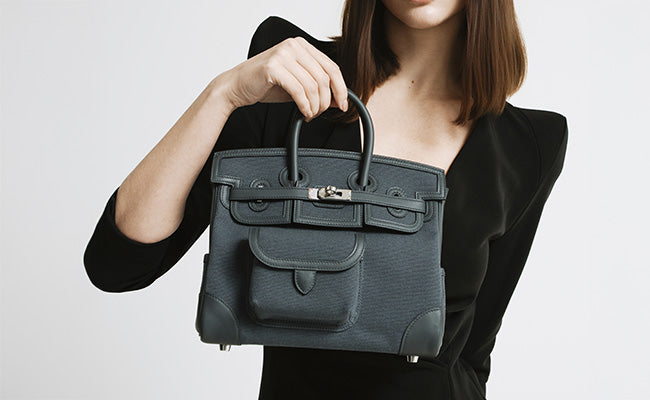
Edge Paint & Piping: How It Ages and When to Refresh
Check out our Hermès collection and Birkin bags!
That gorgeous edge paint on your Hermès bag isn’t just there for show. It’s busy protecting those crisp leather edges from moisture, dirt, and the general chaos of daily life.
Still, edge paint and piping don’t last forever. Knowing when they need a refresh can save your bag from slipping into that “seen better days” category.
Edge paint usually starts showing wear after two or three years of regular use. Cracking, chipping, and fading are your first clues that restoration’s due. Piping’s even more vulnerable, especially on corners and handles where friction is constant.
We’ve all seen stunning bags let down by tired edge work. It’s a bit like pairing a tailored suit with scuffed shoes.
If you spot problems early and know what to do, you can keep your investment looking fresh for years. Whether it’s a little scuff or something more serious, understanding how edge paint ages helps you keep that Hermès perfection intact.
Key Takeaways
- Edge paint and piping usually need refreshing every 2-3 years, though it depends on how you use and care for your bag.
- Early warning signs: cracking, fading, and roughness along the leather edges.
- Good maintenance and proper restoration can really stretch out the lifespan of edge treatments.
Understanding Edge Paint and Piping
Edge paint and piping are those finishing touches that set a luxury bag apart from the crowd. They take specific materials and techniques, and honestly, they make a huge difference in both looks and longevity.
Purpose of Edge Paint in Luxury Bags
Edge paint shields raw leather edges from things like moisture, grime, and everyday wear. Without it, leather edges would fray and break down fast.
Artisans apply several thin coats by hand, letting each layer dry before adding the next. This careful process gives durability and that signature smooth finish.
Quality edge paint offers:
- A barrier against moisture
- Extra structural strength
- A polished, professional look
- Consistent color with the bag
Hermès uses a custom edge paint formula that stays flexible and resists chipping. The paint has to bend with the leather. No cracking or peeling allowed.
Most high-end brands go for three to five coats, sanding each layer before the next. It’s a labor of love, and, well, it’s part of why these bags cost what they do.
The Role of Piping in Design and Durability
Piping reinforces stress points where different pieces of leather meet. These spots take the most abuse during daily use.
Piping is basically a thin cord wrapped in leather or fabric, sewn between two pieces during construction. It strengthens seams and keeps them from tearing.
Piping does a few jobs:
- Reinforces weak spots
- Gives clean, defined edges
- Adds visual interest
- Guards against edge wear at seams
Good piping keeps its shape for decades. Poor piping? It flattens or shifts. You’ll notice the difference right away if you compare a real Hermès to a knockoff.
Hermès usually matches piping to the main leather color, though sometimes they go for contrast on purpose.
Materials Commonly Used for Edge Painting
Pro edge paints rely on acrylic-based formulas made for leather. They stay flexible and stick well.
Top-tier brands often have their own secret blends, balancing looks and durability. No one’s sharing those recipes.
Typical ingredients:
- Acrylic polymers for stretch
- Pigments for color
- UV blockers to fight fading
- Adhesion boosters
Water-based paints clean up easier but don’t last as long. Solvent-based paints go the distance but need careful handling.
Temperature and humidity mess with paint application a lot. Pro workshops control their environment to get consistent, reliable results.
How Edge Paint Ages on High-End Bags
Edge paint on luxury bags doesn’t stay perfect forever. Even Hermès bags eventually show their age. How the paint was applied and how you treat your bag both matter.
Signs of Wear: Cracking, Peeling, and Discolouration
Cracking usually shows up first, especially where the bag flexes most. You’ll see tiny fractures near handles, zippers, and corners. Over time, these cracks grow and break the paint’s protective seal.
Peeling often follows. Once moisture sneaks under the paint, it starts to lift in flakes or strips. Cheap paint peels big; quality paint chips away in smaller bits.
Discolouration means fading, yellowing, or weird color shifts. Whites and light shades show it most. Edges that get a lot of handling or sun are the first to go.
Texture changes are another clue. What was once a glossy, smooth finish turns matte or rough as the top layer wears down.
Environmental Factors That Affect Longevity
Humidity is brutal. Too much moisture softens paint, making it easier to damage, while dry air makes it brittle and likely to crack.
Temperature swings put the paint through expansion and contraction cycles. Bags stored in attics, car trunks, or anywhere with big temperature changes age faster.
UV exposure breaks down the paint’s polymers, causing fading. Direct sun is worst, but even indoor light slowly degrades edge paint.
Friction from handling rubs away paint, especially where you grip the bag or where it brushes against clothing. The original paint job’s quality makes a big difference here.
Typical Lifespan of Edge Paint
Luxury brand Hermès uses top-notch paint that can last 5-10 years with regular use. Its multi-layer process and high-grade materials really hold up.
Mid-range bags often show edge paint wear within 2-4 years. Paint quality varies a lot between brands.
How you use your bag matters most. Bags you carry daily need refreshing sooner. Some vintage Hermès bags, if cared for well, still have their original edge paint after 20 years or more.
Bags used only occasionally and stored properly can keep their edge paint for decades. The trick is keeping them away from moisture, heat, and sunlight between uses.
Piping Wear: When and Why It Happens
Piping takes a beating, especially on Hermès bags that see regular action. Some spots wear out faster than others, and the materials and construction play a huge role in how long piping stays sharp.
Common Stress Points on Hermès Bags
Corners and bottom edges of Birkins and Kellys get knocked around the most. Every time you set your bag down, those spots take the hit, which eventually compresses and cracks the piping.
High-wear spots:
- Bottom corners where piping meets leather
- Handle attachment points
- Edges of closure flaps rubbing against hardware
Structured bags like the Kelly put more stress on their piping than softer styles. Overstuffing or putting the bag on hard surfaces only speeds up the wear.
Temperature swings don’t help either. Cold makes leather brittle; heat causes it to expand and contract, which can loosen piping over time.
Comparing Piping Materials and Their Durability
Hermès uses different leathers for piping, and the choice really matters. Togo and Clemence leather piping is forgiving and ages nicely. Natural oils keep it supple.
Epsom leather piping holds its shape longer but can get sharp creases if damaged. Box calf piping is the fussiest: water spots and scratches stick around for good.
Exotic piping, like alligator or lizard, needs extra care. These materials dry out faster and can crack if you skip conditioning.
Stitching quality is huge. Hand-sewn piping with saddle stitching outlasts machine-stitched versions by years. Each hand stitch spreads out the stress, which helps a lot.
Hidden Damage: What to Watch For
Early piping damage is sneaky. Slight discoloration along the edges means the protective finish is wearing thin, even if the leather looks fine.
Feel for changes in texture. If the piping feels rough or sticky, it’s time to act. Loose threads or gaps between piping and bag show that stitching or glue is giving out.
Watch for:
- Tiny cracks in the leather
- Piping that feels softer than the rest
- Small separations at seams
Color transfer from jeans or other bags often shows up first on piping. It’s worth doing a quick monthly check in good light to catch problems early, before they turn into expensive repairs.
When to Refresh Edge Paint and Piping
The timing of an edge paint or piping refresh can make or break your bag’s looks and value. Climate, how often you use the bag, and the quality of past work all play a part.
Recognizing the Right Time for a Touch-Up
Watch for a few clear signs that it’s time for a refresh. Color fading usually comes first, especially on light shades. Those crisp black or brown edges start looking dull or washed out.
Surface cracks come next: tiny lines that trap dirt and moisture, usually where the bag bends most.
Peeling or flaking is your last warning. Small bits of paint start lifting off. At this stage, you really want to act fast to keep moisture out of the leather.
Rough texture is another giveaway. Run your finger along the edge: if it’s not smooth, the protective layer’s gone.
This decline happens slowly, often over months or years. Monthly checkups help you spot issues while they’re still easy (and cheap) to fix.
Risks of Waiting Too Long
Putting off edge paint maintenance just makes things worse. Water damage is the biggest risk once the paint fails. Bare leather edges soak up moisture, leading to stains, warping, and even weakening the structure.
Color bleeding can happen, too. Damaged edges let dye transfer onto your clothes or the bag’s lining.
Structural problems creep in as moisture gets deeper into the leather, softening the bag’s framework and making it lose those crisp lines that set luxury bags apart.
Letting things go too long ramps up restoration costs. What could’ve been a $50-100 edge paint fix can turn into a $300-500 reconstruction job.
Resale value takes a hit when edge paint is visibly worn. Consignment shops and collectors spot poor edges right away and will knock 20-30% off the price, sometimes more.
Refresh Frequency for Daily vs. Occasional Use
Daily-use bags need edge paint attention every 12-18 months, especially around handles and bottom edges.
Climate matters a lot. Humid places speed up deterioration, while dry air can make paint crack. Adjust your schedule for your environment.
Special occasion bags that stay mostly in storage need refreshing every 3-5 years. Even with light use, environmental factors slowly wear down the edges.
Bags you rotate seasonally usually need attention every 2-3 years. They get more use than special occasion pieces, but less than daily bags.
Storage conditions matter, too. Bags kept in climate-controlled spaces with dust covers keep their edge paint way longer than those stored in heat or sunlight.
Restoration Techniques for Edge Paint
Restoring edge paint takes some skill, and knowing when to call in a pro. The difference between a flawless finish and a botched job often comes down to experience.
DIY vs. Professional Restoration
It’s tempting to grab a brush and fix scuffs yourself. For minor marks on newer bags, light touch-ups with matching paint can work.
But if the damage is serious, or you’re dealing with vintage bags, it’s best to go pro. DIY jobs can leave uneven coverage, mismatched colors, or weird textures that hurt the bag’s value.
DIY pitfalls:
- Hard to find the exact paint
- No access to pro tools like edgers
- Easy to overdo it or get drips
- Tough to blend with the bag’s patina
Professional restoration keeps your bag looking sharp and holds its resale value. DIY is fine for small fixes on newer bags, but not for anything that’s a serious investment.
The Importance of Skilled Artisans
Skilled leather artisans know how paint formulas, application, and leather type all interact. They’ve spent years working with luxury leathers and get how each one reacts to paint.
These pros have access to color-matched paints made just for high-end brands. They know how much pressure to use, how long to let each layer dry, and how the environment affects the finish.
Sometimes, a pro will even tell you that restoring the paint isn’t the right move, especially if the bag’s patina adds to its charm or value.
Their expertise goes beyond just painting. They prep the leather, use the right primers, and finish it off so the repair actually lasts.
Step-by-Step Process for Edge Painting
Restoring edge paint professionally calls for a careful, step-by-step approach. It all starts with surface preparation: cleaning, degreasing, and a bit of light sanding to help new paint stick.
Surface Assessment: The artisan checks the current state of the edges, looking for spots that need more than just a touch-up. Deep cracks might need filling before any paint goes on.
Colour Matching: Getting the color right means mixing up custom paints that not only match the current edge but also take into account how it might age over time.
Application Technique: With specialized edgers or fine brushes, artisans lay down thin, even coats. It’s better to build up color with several light applications than to slather on one thick layer.
Curing and Finishing: Each coat needs proper drying time, and a final protective finish seals the deal. If the room’s too humid or too hot, you’ll see issues like bubbling or weird textures.
Patience really matters here. Rush any step and you’ll likely regret it.
Choosing the Right Tools and Products
Getting those crisp, sharp edges is all about the right tools and materials. Precision matters, and so does the quality of your paint and edger. A good tool makes the difference between something that looks “eh” and a finish that truly pops.
Best Brushes and Paint Edgers for Precision
Honestly, investing in decent edging tools is worth every penny. Pad-style paint edgers work especially well for smooth surfaces: think leather bags, furniture, and the like. Their fabric pads spread paint evenly and help keep lines sharp.
For more detailed spots, like around hardware or curves, brush-style edgers give you extra control. Look for models that fit angled 2-inch brushes and let you adjust the bristle length.
Roller-style paint edgers are your friend for longer runs. Some, like the Wagner Smart Edge, even have a built-in paint reservoir: less stopping, more painting. This one holds 6 ounces and can cover up to 96 feet before you need to refill.
Flip-up wheels on edgers? Yes, please. They prevent paint from smearing where you don’t want it and keep your lines crisp.
Selecting Quality Paints and Sealants
Edge paints need to be tough. Epoxy-based coatings are great for items that see a lot of use. They’re durable and stand up to chemicals.
For leather, go with flexible acrylic paints that move with the bag and don’t crack when the weather changes or you handle them a lot.
Sealants are a must. They keep out moisture, oils, and anything else that could mess up your hard work. Make sure you pick a sealant meant for your material: leather, wood, metal, whatever. They’re not all interchangeable.
If you’re using a roller, pay attention to the nap thickness. A 3/8-inch nap usually does the trick for most smooth or lightly textured edges, holding enough paint without making a mess.
Proactive Care Tips for Edge Paint and Piping
Keeping your Hermès bag’s edges in good shape comes down to daily habits, smart storage, and quick fixes when you spot a problem. These little things go a long way.
Daily Habits to Protect Your Bag's Edges
Let’s be honest: the way we handle our bags every day makes a huge difference. Edges take a beating from normal use.
Lifting and carrying with care matters. For heavier bags like Birkins or Kellys, use both hands and grab the base or handles, not the flap edges.
Avoid rough surfaces. Restaurant tables, car seats, office desks. They all have a knack for scratching edge paint. Lay down a dust bag or a soft cloth before you set your bag down.
Keep bags dry. Rain, spills, even just humidity can mess up the paint. Check the weather, and bring something to cover your bag if needed.
Rotate your collection. Using the same bag every day wears it out fast. Switch things up so the wear spreads out.
Storage Solutions for Maximum Longevity
How you store your bags matters. Maybe more than you think.
Original dust bags and boxes are best for long-term storage. They let your bag breathe and keep out dust and light. Never use plastic; it traps moisture and can ruin leather.
Maintain shape with stuffing. Acid-free tissue or bubble wrap helps bags keep their form and protects corners and edges from cracking.
Control temperature and humidity. Store bags in a climate-controlled spot: ideally 18-22°C with 45-55% humidity. Basements and attics are risky because of temperature swings.
Give each bag its own space. Don’t stack or cram them together. They need room to breathe and to avoid rubbing against each other.
Dealing with Minor Blemishes Before They Worsen
Jumping on small issues early can save you from big, expensive repairs.
Clean scuffs right away with a slightly damp microfibre cloth. Use gentle circles; no need to scrub hard.
Edge paint protectors can go on any area that’s starting to show wear. Clear films for luxury leather can slow down further damage.
Loose piping threads? Snip them with small scissors. Don’t pull! Pulling can make things much worse.
Take photos of changes. It’s easier to track wear and helps if you ever need to show a pro for restoration. Snap a few shots of high-wear spots every month.
Know when to call in the pros. Deep scratches, big paint chips, or piping that’s coming apart: those aren’t DIY jobs.
Frequently Asked Questions
People ask about edge paint maintenance all the time, DIY fixes, when to go pro, and what to do about cold weather or daily wear. Here’s what we hear most often.
How do you spruce up edge paint that's started to look as loved as Grandma's vintage clutch?
Light scuffs? A damp microfibre cloth usually does the trick. Just don’t rub too hard or you’ll take off more paint.
For deeper scratches, a cotton swab dipped in leather cleaner can blend things in. Always work in thin layers and let each one dry before adding more.
Some folks use matching nail polish for tiny touch-ups, but honestly, finding the right color is tough. Edge paint pens made for leather are more reliable and last longer.
When your piping's looking more 'drab' than 'fab', what's the go-to method for a refresh?
First, figure out if the leather needs conditioning or if it’s just the paint. Clean piping gently with a leather-safe cleaner.
Pros will strip the old paint, condition the leather, and then apply new edge paint in several thin coats. Takes a few days for everything to cure.
For minor scuffs, you can use leather paint that matches your bag’s hardware. Always test any product on a hidden spot first.
Is there a bougie DIY fix for edge paint wear, or should I leave it to the pros?
Small chips and light scuffs? You can handle those at home with good leather edge paint. The secret is super-thin layers, letting each one cure for a full day.
But if the paint’s coming off in big patches or you see damaged leather underneath, it’s time for a professional. DIY repairs on major issues usually make things worse.
If you’ve got a high-value bag (especially Hermès), don’t risk it. Professional restoration is worth it for the resale value alone.
Any insider tips on how to keep the edge paint from giving away how much I actually use my bag?
Rotate your bags. Don’t let one take all the hits. Even your favorites need a break.
Store each bag with its dust cover and avoid stacking. Most edge paint damage comes from poor storage.
When picking up your bag, grab the body, not the edges or corners. That one habit can double the life of your edge paint.
Condition bag bodies every few months, but keep conditioner off the painted edges. It can soften and damage the paint.
What's the A-list way to know when my bag's edge paint has gone from charmingly worn to tragically torn?
If you see flaking that exposes raw leather, it’s time for action. Exposed leather can soak up moisture and get damaged fast.
Deep gouges that snag your nails or threads? Those need fixing right away. They’ll only get worse.
If the paint looks chalky or way lighter than it used to, that’s a sign it’s failing. At that point, a professional can tell you if you need touch-ups or a full refinish.
Could harsh Canadian winters be the culprit behind premature edging issues, or am I just unlucky?
Canadian winters really do a number on edge paint, thanks to those brutal freeze-thaw cycles and all the salt everywhere. The indoor heating doesn’t help either. It dries everything out and makes paint brittle.
When you’ve got -30°C outside and a cozy +20°C inside, the leather and paint just keep expanding and shrinking. That constant back-and-forth? It leads to tiny cracks that only get worse as the season drags on.
If you want to keep your bags in decent shape, stash them away from heat vents and maybe run a humidifier. I’d even say try rotating your bags by season. Let the winter-weary ones rest up when the weather’s nicer.




